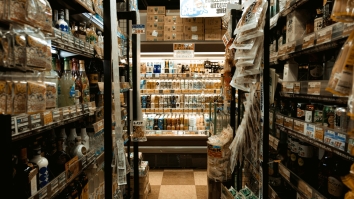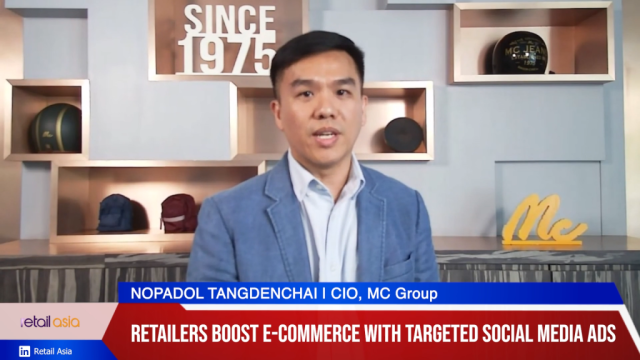Driving the trends in delivering daily essentials
Introducing shopper-focused innovation has been a priority for most Asia players.
As grocery delivery services today increasingly innovate to convey the best user experience for customers, Muneerah Bee speaks with some online grocery players to gather their thoughts on the significant changes happening in grocery delivery that retailers in Asia should be aware of.
There has been rapid growth in the grocery delivery industry in Asia, especially in the past two years, with the introduction of more players in the space offering various benefits such as shorter delivery times, regular discounts and a wider selection of items.

HappyFresh Malaysia has expanded its range of service to the Klang Valley area, Penang, and Johor Bahru, and it is also planning to expand to other cities in Malaysia in the near future.
Christina Lim, vice-president, Marketing, honestbee (Singapore), observes that introducing shopperfocused innovation has been a key priority for most players in the Asian retail scene, along with the growing importance of leveraging data science and business intelligence to introduce product improvements that enhance the consumer experience.
“The online environment in Asia is also more fluid compared to other markets. The line between online and offline is now becoming increasingly blurred as online businesses partner with offline retailers, while offline retailers experiment with online solutions. Collaboration between online and bricks-and-mortar retailers are set to increase,” she explains.
Shoppers also want free shipping without a minimum order size, according to Rajni Gupta, chief operating officer and founder of sustainability-focused online mart TwentyOff, and they are becoming more demanding with emphasis on on-time delivery in full.
HappyFresh Malaysia managing director Hunhui Hu adds that customers’ busy lives have made it a hassle to do groceries offline and people from all walks of life are starting to rely more on online grocery delivery.

“Logistics is always one of our evergrowing areas. One of our missions is to make logistics from store to door seamless.” — Hunhui Hu, Managing Director, HappyFresh Malaysia
He says: "Throughout the year, customers are expecting constant development, service quality and, at the end of the day, better price. Pricing is one of the factors that impact our customers, be it mass or upscale, everyone pays more attention to prices, especially after the Sales and Services Tax (SST) implementation [in Malaysia]. What we do at HappyFresh is to ensure we give impeccable service quality and prices through our campaigns and product discount.”
Given that the platforms to purchase and receive grocery products are becoming more and more plentiful and sophisticated for the end-consumer, the basic convenience offered by last-mile logistic delivery is no longer added value but is becoming a ubiquitous new normal, observes Neil Beckitt, head of Global Supply Chain and Data at BottlesXO International, which delivers wines, craft beers and spirits.
“Retailers in this area need to adapt to find new ways to offer unique added value in order to attract and retain their customer base. The plethora of options at the consumers’ fingertips mean it’s never been more important to be dynamic in your product offering and engaging with your content. Customers are also much more educated when it comes to food safety and quality assurance processes; they need to feel confident that you are a retailer they can trust. And if your company doesn't provide this, there will be several others who will be waiting behind you,” he comments.
Challenges on the road
Needless to say, running a grocery delivery business in Asia, especially a large-scale one, is competitive and comes with several logistical challenges. Trying to meet the needs of the increasingly demanding shoppers is adding a lot of cost to the operations and for a low-margin industry like grocery, this can be crippling to the business, Gupta of TwentyOff shares.

Since we launched in 2015, we have learnt a great deal about the importance of ensuring logistics visibility to maintain efficiency and obtain a higher level of consumer satisfaction.”
— Christina Lim, Vice-President, Marketing, honestbee (Singapore)
To tackle the high operational costs for delivery to end-customers, honestbee (Singapore)’s data and engineering teams leverage machine learning algorithms, which help the company plan its deliveries effectively to cope with ongoing demand across its various business verticals.
Lim says: “This technology-led approach is complemented by a strong Operations team that responds to honestbee’s manpower needs accordingly to react to any immediate surge in demand and ensure that all orders are delivered on time.”
HappyFresh Malaysia overcomes logistical challenges by constantly optimising its radius and finding the alternative to provide timely delivery for its B2C and B2B customers. Hu adds that the company also ensures that its fleets are experienced and sufficiently trained to keep up with orders. On the field, the homegrown e-commerce firm prepares its fleets to face the unexpected, such as ‘out of stock’ situations at the hypermarket.
He says: “We are constantly working together with our retailers’ partners to integrate and minimise this issue. To add, cold chain delivery is another challenge: our fleet has to race against time to make sure that the ice cream, butter and other frozen items won’t melt on their way.”
The absence of a reliable yet affordable cold chain is another similar challenge for TwentyOff, Gupta shares. It is understandably vital to maintain consistency when delivering ready-to consume products.
Beckitt of BottlesXO shares: “Ensuring consumables are at the correct temperature and in the right packaging for every order requires a huge amount of staff training and process monitoring. Enabling internal visibility throughout your logistics process and commitment to your values from the wider team are crucial to providing intended levels of customer experience.”

honestbee provides on-demand grocery delivery service in 16 cities across eight countries in Asia. It has also extended its business to food and laundry delivery.
Likewise, to ensure the freshness and quality of the products and ingredients, honestbee (Singapore) constantly provides training for its “Shopper Bees” so that they can handpick the freshest produce as and when its customers place their orders for the items.
Beckitt continues: “In Asia, there is definitely a lack of awareness of how grocery products need to be transported and stored during various steps of the supply chain. You need to be sure your in-house logistics and any third-party logistics (3PL) partners have the correct processes and safety checks in place to ensure your products are arriving in the best possible condition.”
Improving logistics visibility, especially in the last mile, can also help overcome some challenges as GPS-based driver tracking proved to be a huge step forward in providing visibility to consumers. However, more can be done to improve and integrate more intelligent estimated delivery times by accounting traffic, weather, average speed of the individual driver and other factors which can give customers better idea of the exact moment they will receive their goods. “Digitally-enabled temperature monitoring during the delivery for ready-to-consume food and beverages can also offer added value to consumers and increase the visibility,” Beckitt adds.
To aid its riders to move faster and safely, no matter what the weather is, HappyFresh Malaysia’s riders’ bags are designed to be waterproof, light and able to roll like a suitcase. “For the customers, we update them through our ‘My Order Status’ page so they will be able to know what's their shopping progress. We are also working towards having an easier communication channel between shoppers/riders and our customers,” Hu says.
Lim shares three pointers that honestbee (Singapore) has been continuously leveraging to better improve the way it delivers its services. Firstly, companies should harness data meaningfully to help optimise manpower and time resources, as this can help to enable more efficient pick-ups and prompt deliveries. Secondly, develop a system that allows clear and quick communication between fleet managers and drivers to identify any unexpected problems or issues early on and implement solutions in real time. Lastly, two-way communication with the customer is encouraged as customers want to know if they can expect their deliveries on time or whether there are any issues that they need to be aware of.

"Logistics challenges can be overcome by increasing drop density, using sustainable vehicles and packaging solutions, and data driven efficiencies.” — Rajni Gupta, Chief Operating Officer and Founder, TwentyOff
Data-driven efficiencies
It is widely known that data and business intelligence are vital components for any company wishing to be successful in the FMCG industry, but especially so for food delivery companies. Predictive analytics play a huge role in optimising demand planning and ensuring product list disruption is minimised for the end-consumer. Beckitt emphasises: “I’ve found consistency is hugely valued by our consumers. Picking apart demand cycles in high levels of detail and learning regarding external and internal influences on purchasing behaviour are undoubtedly required in order to be prepared to fulfil our service obligations.”
Besides data’s role in increasing operational efficiency to reduce cost and provide more predictive algorithms to guide better forecasting, data speaks about the demand and helps HappyFresh Malaysia in running and making relevant decisions in the company as well as assists to foresee season and off-season trends. “In terms of logistics, data helps our Operations department to forecast the number of fleet that we’ll need, even down to the simpler things like how big the carrier on their motorbike should be. Aside from that, we also use the data to see which stores have high demand in certain areas and prepare us for the logistics support needed,” Hu expounds.
[caption id="attachment_9233" align="alignright" width="416"] With a mission to help consumers get the best value for monthly essentials while helping save the environment, sustainability is at the heart of TwentyOff’s business model.[/caption]
With a mission to help consumers get the best value for monthly essentials while helping save the environment, sustainability is at the heart of TwentyOff’s business model.[/caption]
As for honestbee, the on-demand delivery service believes in using data efficiently to ensure impactful business results by harnessing data not only to derive insights around demand, but also to anticipate shifts in consumer behaviour in real time and also to better manage supply.
“With a mission to better serve the needs of customers, our Data team works with our Operations team to constantly address challenges and effectively reduce resource consumption. We also leverage our technology and deep understanding of data to further improve the product features and special promotions for our consumers,” Lim says.
She adds that the e-tailer also harnesses its technology to equip partners with data and resources that aim to provide a better understanding of their sales performance on honestbee in a bid to extend their reach and further enhance their product offering.
Fleet flexibility
Data also plays a key role in maximising fleet management in order to provide timely deliveries. For example, when it comes to labour management, BottlesXO’s Beckitt advises retailers to be reactive with shift plans to accommodate changing circumstances such as the weather or flash promotions. “Knowing how many delivery staff you will need on duty to match predicted levels of orders is highly important,” he says.
He also advocates route optimisation from the dispatch team to the delivery team as the key to efficiency and driving down those delivery times during peak hours. “We operate in areas with very high population density; smart order assignment makes a huge difference to the average distance travelled to complete a series of orders that our drivers undertake,” he shares.
honestbee (Singapore) also works very closely with its fleet and “network of bees” who are trained to meet the demands during peak periods. Lim discloses: “The biggest concern that comes with fleet management is the operational costs. At the moment, our priority in this area is mainly around optimising fleet management so as to reduce wastage but not compromise efficiency when it comes to making prompt deliveries. In line with this, we are currently analysing order activity so we can plan for shorter delivery distances and better order distribution among our Delivery Bees.”
In Malaysia, HappyFresh makes sure that the company has enough fleet in every cluster and the distance between the shop and customers are in a range where they can reach the destination in an hour. To make it possible for the riders to pool their orders in one go rather than making a few trips, the online platform optimises picking methods and handover so that it can be done in the shortest time possible and ensures that the transportation vehicles are always in good condition.
Future of food delivery
Hu is confident that Malaysia’s e-commerce landscape is at its peak and there will be more people shifting their shopping habit from offline to online. “What I see is that more people from other cities would need grocery delivery on-demand to keep up with their busy lives. This would happen even faster when the online grocery delivery can offer what offline stores cannot — such as customising shopping experience as well as bundling [the grocery] together with recipes, and so on,” he says.
With the emergence of the app marketplaces taking over a share from standalone stores and businesses, Beckitt predicts a greater movement towards home delivery and mobile commerce in Asia, citing the huge development in the WeChat mini-programme in China as a blueprint of what is to come throughout the region.
“My second prediction is that 2019 will finally be the year that blockchain-based tech finally becomes regularly integrated into food supply chains all the way to the end-consumer. There will be a huge push into provenance and visibility of where your products have been, how they have been transported and their authenticity from source to the point of consumption,” he affirms.
Sharing the option that the grocery delivery business is ripe for disruption, Lim foresees services developing faster and in more efficient ways for customers to get groceries — perhaps through partnering same-hour delivery services. “The grocery delivery business is undergoing a transformational phase, as it goes beyond a transactional experience into something more immersive and experiential. Consumers are starting to place greater value on offline experience as well as online and thus are looking for many ways to experience a brand prior to making a purchase,” she shares.
As such, we will be seeing more online-offline integrations moving forward as companies look towards creating more immersive experiences with consumers that connect with them on a more personal level. Leveraging technology and data analytics, the grocery delivery business will continue working towards offering customers more exciting products, more conveniently, and at lower price points, she says.
Sustainability factor
Gupta highlights that shoppers will be more driven by sustainable logistics solutions in the future. “No one is seriously trying to solve this problem. We must try to reduce the number of deliveries and ensure all vehicles are electric-powered. We must also eliminate packaging waste by using only 100% reusable secondary packaging,” she declares.
TwentyOff customers are encouraged to order fewer but bigger deliveries which, according to Gupta, not only reduces carbon emissions but also reduces last-mile costs to less than 5% of revenue, and these savings are passed back to shoppers to incentivise them to make bigger orders. Notably, deliveries from TwentyOff are put together in reusable Ikea bags so the company has “zero plastic bag footprint”.
HappyFresh Malaysia implements a similar policy for reusable bags for purchases of more than RM200 (US$48). Hu shares that HappyFresh is also working towards finding more ways for sustainable supply chains: “Aside from pooling orders, we encourage our riders to use motorcycles instead of cars or lorries, unless it is deemed necessary.”
Along a similar vein, Lim says honestbee (Singapore) understands the importance of businesses having a sustainable supply chain management, especially as there is now an emphasis on moving towards a cleaner, greener and more socially responsible society. “Right now, we are still working out a plan that would work best for us in line with the overall needs of the business. However, we will continue to strive to operate and conduct our business in a more sustainable manner and eventually develop a corporate sustainability programme, which also ensures that our suppliers and partners are sustainable themselves,” she concludes.
The added personal touch

The photo of the delivery personnal is turned into an animated GIF which is sent to the customer as part of BottlesXO’s order push notifications.
DELIVERING high-quality wines, beers and spirits in China, Hong Kong and Singapore, BottlesXO believes that each delivery is not just a matter of order fulfilment but also an opportunity to offer customers a magic moment.
Neil Beckitt, head of Global Supply Chain and Data, BottlesXO International, shares: “The company aims to personalise the interaction between its delivery personnel and the customer by adding personal touches to both digital and physical interaction with the customer while ensuring our products are delivered at the perfect drinking temperature and in peak condition.”
All delivery personnel at BottlesXO go through a photoshoot before they start delivering, but instead of a boring profile picture, they are encouraged to have some fun, express themselves and show some personality. The photo is then turned into an animated GIF which is sent to the customer as part of BottlesXO’s order push notifications.
“These pushes will introduce the drivers with their first names and build a connection between them and the customers at various stages of the delivery process, then just a few minutes later you will have a knock at the door with a polite smiling face introducing himself by his first name. We’ve had really amazing feedback on this feature and it is something our customers find really alluring and memorable,“ Beckitt says.























 Advertise
Advertise








